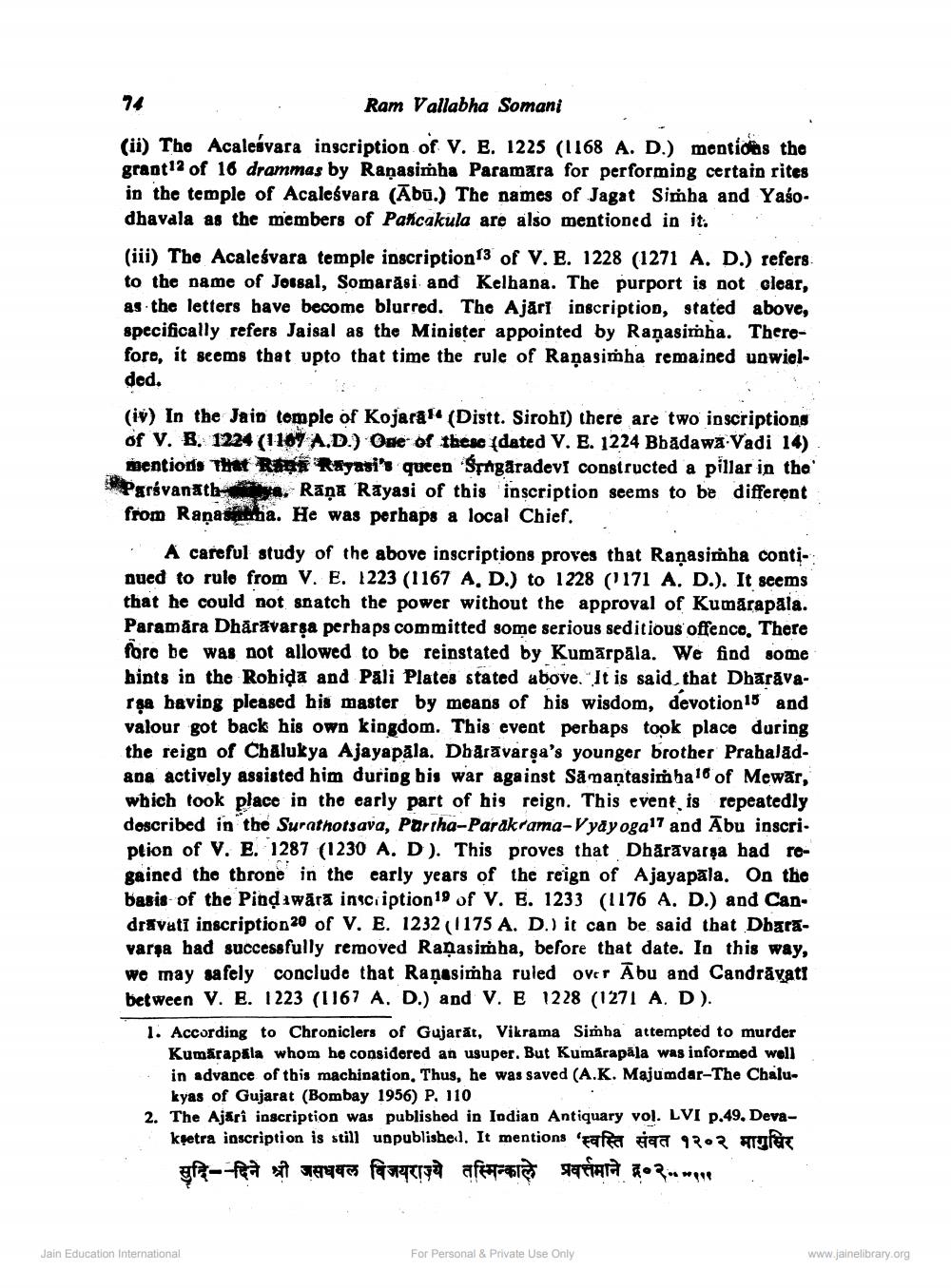________________
74
Ram Vallabha Somani (ii) The Acalesvara inscription of v. B. 1225 (1168 A. D.) mentions the grant12 of 16 drammas by Raņasimha Paramara for performing certain rites in the temple of Acaleśvara (Ābū.) The names of Jagat Simha and Yasodhavala as the members of Pancakula are also mentioned in it. (iii) The Acaleśvara temple inscription13 of V. E. 1228 (1271 A. D.) refers to the name of Jorsal, Somarāsi and Kelbana. The purport is not clear, as the letters have become blurred. The Ajari inscription, stated above, specifically refers Jaisal as the Minister appointed by Ranasimha. Therefore, it seems that upto that time the rule of Raņasimha remained unwielded. (iv) In the Jaip temple of Kojarafi (Distt. Sirohi) there are two inscriptions of V. B. 1224 (11047 A.D.) One of these dated V. E. 1224 Bbadawa Vadi 14)
mentiods That Rai Rayasi's queen Singäradevi constructed a pillar in the **Parsvanath- Rāņa Rayasi of this inscription seems to be different from Raņashia. He was perhaps a local Chief.
A careful study of the above inscriptions proves that Ranasimha continued to rulo from V. E. 1223 (1167 A, D.) to 1228 (1171 A. D.). It seems that he could not snatch the power without the approval of Kumarapala. Paramāra Dhäravarsa perhaps committed some serious seditious offence. There fore be was not allowed to be reinstated by Kumārpāla. We find some hints in the Rohida and Pali Plates stated above." It is said that Dharavarga having pleased his master by means of his wisdom, devotion 15 and valour got back his own kingdom. This event perbaps took place during the reign of Chalukya Ajayapāla. Dhårāvarşa's younger brother Prahaladana actively assisted him during his war against Såmantasimha16 of Mewar, which took place in the early part of his reign. This event is repeatedly described in the Surathotsava, Partha-Parakrama-Vyayoga17 and Ābu inscri. ption of V. E. 1287 (1230 A. D). This proves that Dhårāvarşa bad rogained the throne in the early years of the reign of Ajayapala. On the basis of the Pindawārā insciiption 19 of V. B. 1233 (1176 A. D.) and Candravati inscription 20 of V. E. 1232 (1175 A. D.) it can be said that Dbaravarsa had successfully removed Ranasimha, before that date. In this way, we may safely conclude that Ranasimha ruled over Ābu and Candrāvati between V. B. 1223 (1167 A. D.) and V. B 1228 (1271 A. D). 1. According to Chroniclers of Gujarăt, Vikrama Simba attempted to murder
Kumārapala whom he considered an usuper. But Kumārapāla was informed well in advance of this machination. Thus, he was saved (A.K. Majumdar-The Chalu
kyas of Gujarat (Bombay 1956) P. 110 2. The Ajari inscription was published in Indian Antiquary vol. LVI p.49. Deva
ksetra inscription is still unpublished. It mentions after saa 93.2 aufer सुदि--दिने श्री जसधवल विजयराज्ये तस्मिन्काले प्रवर्तमाने द्र०२......
Jain Education International
For Personal & Private Use Only
www.jainelibrary.org




